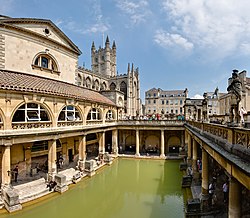
Bath is a city in the ceremonial county of Somerset, England, known for and named after its Roman-built baths. At the 2021 Census, the population was 94,092. Bath is in the valley of the River Avon, 97 miles (156 km) west of London and 11 miles (18 km) southeast of Bristol. The city became a UNESCO World Heritage Site in 1987, and was later added to the transnational World Heritage Site known as the "Great Spa Towns of Europe" in 2021. Bath is also the largest city and settlement in Somerset.

Aquae Sulis was a small town in the Roman province of Britannia. Today it is the English city of Bath, Somerset. The Antonine Itinerary register of Roman roads lists the town as Aquis Sulis. Ptolemy records the town as Aquae calidae in his 2nd-century work Geographia, where it is listed as one of the cities of the Belgae.
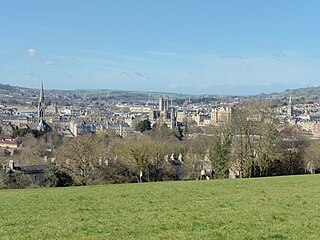
Bath and North East Somerset (B&NES) is a unitary authority district in Somerset, South West England. Bath and North East Somerset Council was created on 1 April 1996 following the abolition of the county of Avon. It is part of the ceremonial county of Somerset.

In the localised Celtic polytheism practised in Great Britain, Sulis was a deity worshiped at the thermal spring of Bath. She was worshiped by the Romano-British as Sulis Minerva, whose votive objects and inscribed lead tablets suggest that she was conceived of both as a nourishing, life-giving mother goddess and as an effective agent of curses invoked by her votaries.

Thermae Bath Spa is a combination of the historic spa and a contemporary building in the city of Bath, England, and reopened in 2006. Bath and North East Somerset council own the buildings, and, as decreed in a Royal Charter of 1590, are the guardians of the spring waters, which are the only naturally hot, mineral-rich waters in the UK. The Spa is operated by YTL Hotels.

A spa is a location where mineral-rich spring water is used to give medicinal baths. Spa towns or spa resorts typically offer various health treatments, which are also known as balneotherapy. The belief in the curative powers of mineral waters goes back to prehistoric times. Such practices have been popular worldwide, but are especially widespread in Europe and Japan. Day spas and medspas are also quite popular, and offer various personal care treatments.

In ancient Rome, the apodyterium was the primary entry in the public baths, composed of a large changing room with cubicles or shelves where citizens could store clothing and other belongings while bathing.

Aquae Arnemetiae was a small town in the Roman province of Britannia. The settlement was based around its natural warm springs. The Roman occupation ran from around 75 AD to 410 AD. Today it is the town of Buxton, Derbyshire in England.

The Royal Pump Rooms is a cultural centre on the Parade in Leamington Spa, Warwickshire, England. It was the most famous of several spa baths opened in Leamington between the late-18th and mid-19th centuries. People would travel from throughout the country, and indeed Europe, to benefit from treatments using the town's healing waters. When 'taking the waters' became less fashionable after the mid-19th century the Pump Rooms became Leamington's only surviving spa facility, later also being extended to include the town's public swimming pool. After a major redevelopment in 1997-99 the building now houses Leamington Spa Art Gallery & Museum, a public library, a Tourist Information Centre, cafe and assembly rooms. It is a Grade II listed building.
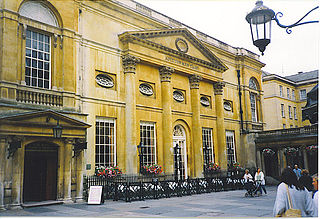
The Grand Pump Room is a historic building in the Abbey Churchyard, Bath, Somerset, England. It is adjacent to the Roman Baths and is named for water that is pumped into the room from the baths' hot springs. Visitors can drink the water or have other refreshments while there.

The Paragon in the Walcot area of Bath, Somerset, England is a street of Georgian houses which have been designated as listed buildings. It was designed by Thomas Warr Attwood. It now forms part of the A4.
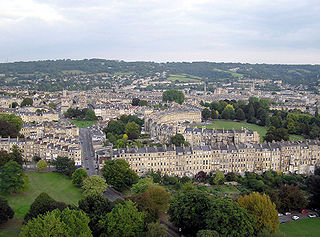
The buildings and architecture of Bath, a city in Somerset in the south west of England, reveal significant examples of the architecture of England, from the Roman Baths, to the present day. The city became a World Heritage Site in 1987, largely because of its architectural history and the way in which the city landscape draws together public and private buildings and spaces. The many examples of Palladian architecture are purposefully integrated with the urban spaces to provide "picturesque aestheticism". In 2021, the city was added to a second World Heritage Site, a group of historic spa towns across Europe known as the "Great Spas of Europe". Bath is the only entire city in Britain to achieve World Heritage status, and is a popular tourist destination.

Aquae Iasae was the Roman settlement and Roman bath in the area of present city Varaždinske Toplice, Croatia. Today it is the name of the archaeological site.
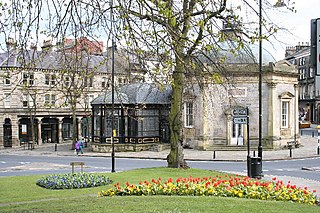
The Royal Pump Room is a Grade II* listed building in Harrogate, North Yorkshire, England. Today it houses the town's museum – operated by North Yorkshire Council. It was formerly a spa water pump house. It is located in Crown Place in the western part of Harrogate town centre, opposite the town's Valley Gardens park. It is bounded by two streets, Crescent Road and Royal Parade. Today, the Pump Room consists of both the original 1842 stone rotunda and a glazed annexe which was opened in 1913. The Pump Room offered guests of the town an all weather facility where they could drink sulphur water which was pumped on site from a natural spring known as the Old Sulphur Well. The building also had a social element to it as it provided guests with a place to meet friends and get to know others.

The Beau Street Hoard, found in Bath, Somerset, is the fifth-largest hoard ever found in Britain and the largest ever discovered in a British Roman town. It consists of an estimated 17,500 silver Roman coins dating from between 32 BC and 274 AD. The hoard was found on Beau Street about 150 metres (490 ft) from the town's Roman Baths, built when Bath was a Roman colony known as Aquae Sulis.

The following is a timeline of the history of the city of Bath, Somerset, England.

The Bath curse tablets are a collection of about 130 Roman era curse tablets discovered in 1979/1980 in the English city of Bath. The tablets were requests for intervention of the goddess Sulis Minerva in the return of stolen goods and to curse the perpetrators of the thefts. Inscribed mostly in British Latin, they have been used to attest to the everyday spoken vernacular of the Romano-British population of the second to fourth centuries AD. They have also been recognised by UNESCO in its Memory of the World UK Register.

St Ann's Well is an ancient natural warm spring in Buxton, Derbyshire in England. The drinking well is located at the foot of The Slopes and opposite the Crescent hotel and the Old Hall Hotel.
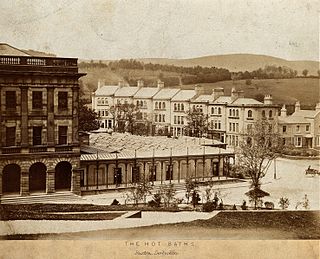
The Buxton Baths using natural thermal spring water are in Buxton, Derbyshire, England. The baths date back to Roman times and were the basis for developing Buxton as a Georgian and Victorian spa town. The present buildings of the Thermal Baths and the Natural Mineral Baths were opened in the 1850s. They are positioned either side of the Buxton Crescent at the foot of The Slopes in the town's Central Conservation Area. They are both Grade II listed buildings designed by Henry Currey, architect for the 7th Duke of Devonshire.
